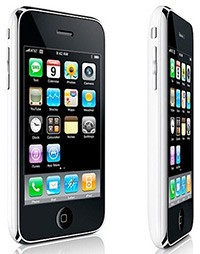
The first iPhone arrived at a time that suggested Apple needed to protect its iPod franchise -- but Apple delivered something that was much more than an MP3 player that could make phone calls. You probably won't be editing any iMovies on it for some time, but in the iPhone Apple has essentially delivered Macintosh 2.0. It's portable. It's affordable. It's connected. And it runs OS X, complete with its own breakthrough pointing device, your finger. Whereas the first Mac came with productivity applications MacWrite and MacPaint, the iPhone came with applications for Web surfing, e-mail, and consuming media, the evolution of what much personal computing has become.
Furthermore, Apple has shown that it has learned from mistakes it made with the first Mac. Whereas early monochrome Macs were a tough sell for game developers, Apple has highlighted games as some of the most impressive early third-party applications for the iPhone and iPod touch. And whereas Apple was notorious for keeping Mac prices high for many years, the next-generation iPhone takes advantage of carrier subsidies for an out-of-pocket price of $200 in the US (and even less or free in some countries). Despite the many changes that have transformed the software industry since 1984, the iPhone, along with its SDK, development tools and app store, have the potential to bring the work of OS X developers to millions of people who don't own Macs -- that is, if Apple lets them.
As the sole distributor of iPhone applications, Apple has absolute authority on what programs are made available to customers, and can refuse distribution of any application at will. It is the iFunnel, imposing more control than is exerted over most smartphones -- or even many feature phones that can access Java applications -- that are marketed off of the carriers' deck. Apple has already outlined some kinds of applications that it will disallow: programs that feature pornography, compromise privacy, hog bandwidth or device resources, or are illegal or malicious. However, there seem to be many applications that don't fall into these categories, applications that vendors say are ready to go, but which Apple has not yet approved, such as Adobe's Flash or TomTom's navigation software.
As one product manager at a large, longtime cross-platform developer that has created an innovative and free iPhone application recently put it, anyone can create anything using the iPhone emulator. The trick is getting it onto the device. The manager said that his company had the scale and historic relationship with Apple to instill confidence that it could get its app approved. He noted Apple has been overwhelmed with submissions, though, and wants to maintain a good user experience at launch, even if that means featuring a small portion of applications that are ready to go.
Operating on a cellular network certainly complicates software development in a way that the gung-ho evangelists of the Mac's early days didn't need to consider. And by scrutinizing applications for quality and polish, Apple can keep the iPhone user experience more stable and consistent than that of early Macs. But, as Steve Jobs admitted after Apple first locked out all alll third-party native iPhone applications, Apple is a platform company and ultimately its value in being in the cell phone market ties back to that heritage.
Being too restrictive on which applications are allowed for the iPhone won't right another wrong of the first Mac's development. It will stifle a platform that Apple has clearly committed to with an SDK. For the benefit of iPhone and iPod touch users, OS X developers, and ultimately Apple itself, the iFunnel should let quality programs flow freely.
[ Via: Engadget ]
[ Tag: Apple,featured,features,iPhone,SDK,switched on,switchedon ]
No comments:
Post a Comment